Top News
Pinkerton: Republican #Resistance Comes to Electric Vehicles at the D.C. Auto Show
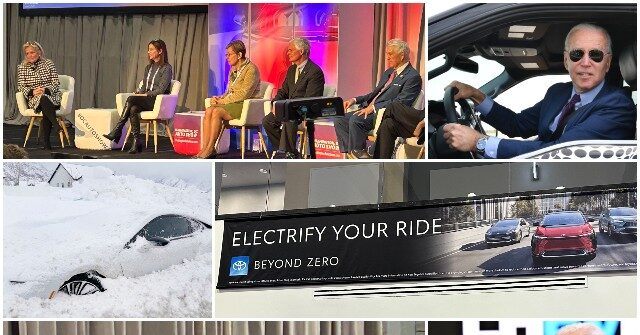
Corporate trade shows are usually slick but staid. Companies spend big bucks—on lighting, staging, and all-around glamorizing—to make the shows slick, and yet at the same time, they’re staid. Kinda dull.
Companies don’t want controversy. Angry words generate unpredictable headlines, taking the focus off the product. So, the goal is a smooth “frictionless” platform for selling stuff. Yet sometimes, differences of opinion emerge and sparks fly. That’s bad news for comms planners, but good for news consumers, because we learn more from free debate than from stilted spin.
Case in point: The Washington, DC, Auto Show, where on January 18, genuine differences of opinion, Republican vs. Democrat, were heard: Who should decide the fate of the auto industry: the green technocrats? or the customers?
The Toyota EV advertisement display at the Washington, DC, auto show on Thursday, January 18, 2024, in Washington, DC. (James Pinkerton/Breitbart News)
In D.C., as anywhere, the companies mostly want to tout autos, and yet given that it’s Powertown, the show included a Public Policy Day. This author has attended several of these policy days in past years, and they have always featured mid-level government officials who intone, in rounded terms, about “partnerships” between the public and private sectors. The federal government will help the auto industry—bail it out, if need be—and in turn, the industry will build cars (hopefully, but not necessarily, in the U.S.) And, of course, abide by all environmental laws and goals. This cronyish symbiosis is summed up in electric vehicles (EVs).
General Motors (GM) is an eager symbiot. Once the largest corporation in the world, GM went bankrupt in 2009; Uncle Sam chipped in billions to pull it out of the pit. Ever since, the company has been, shall we say, grateful to the feds. GM is now a reliable cheerleader for any green, or woke, idea that comes along. For instance, the CEO, Mary Barra. According to her corporate bio, Barra is on the board of The Walt Disney Company, and also, “she serves as the Chair and founding member of GM’s Inclusion Advisory Board.” You get the idea. No wonder Democrats love her. As President Joe Biden said to her in 2021, “Mary, you are a . . . you’re an incredible leader. You really are.” With subsidies and flatteries such as that, of course Barra and GM are all in for EVs. The company proclaims, “Committing to an All-Electric Future.”
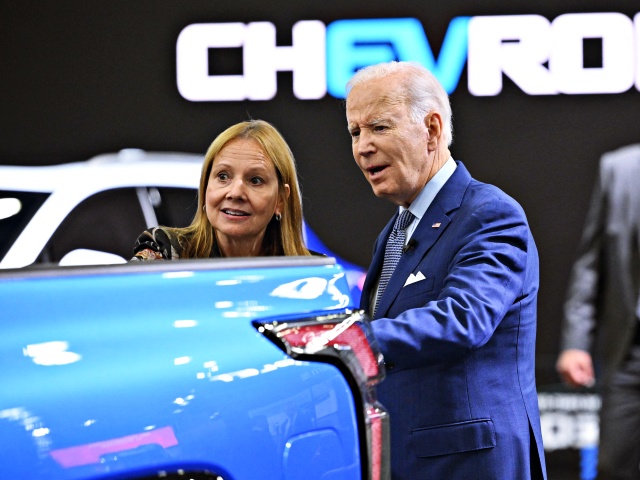
President Joe Biden with General Motors CEO Mary Barra tour the Chevrolet exhibit at the 2022 North American International Auto Show in Detroit, Michigan, on September 14, 2022. (MANDEL NGAN/AFP via Getty Images)
In fact, the whole industry is there for EVs. Toyota was the sponsor of the policy day, and its signage was everywhere: “Electrify your ride. Beyond Zero.” As in net zero CO2 by mid-century, the great green dream. At the session, a Toyota salaryman said the company’s goal was to give consumers “every possible choice for reducing their carbon footprint.” Ah yes. Buyers have “choice”: any number they want, so long as it’s zero. That was the intended messaging for the 2024 auto show: government and corporations in green togetherness. The same as, in fact, the 2023 auto show.
Yet things have changed. In 2023, the buzz was about tapping the money gushers from the recently passed American Rescue Plan ($1.9 trillion), the Inflation Reduction Act ($891 billion, although some say more), and the infrastructure bill ($1.2 trillion).
But in 2024, amidst inflation, higher interest rates, and a series of negative news items–capped by a cold spell that made a mockery of EVs as all-weather transportation—”EVthusiasm” has, well, cooled.

An abandoned electric car is buried in snow in Draper, Utah, on February 23, 2023. (GEORGE FREY/AFP via Getty Images)
Most notably, two Republican Members of Congress were icy. They were Reps. Mike Kelly of Pennsylvania and Roger Williams of Texas. At a bipartisan panel at the show, Kelly—himself a car dealer prior to Congress—said the whole idea of EVs was a “false narrative.” They only sell, he jibed, with huge federal subsidies. For his part, Williams ripped the feds for “trying to shove EVs down our throats.” Instead, he continued, Americans should be free to buy what they want to buy.
The two Democrat Members of Congress on the panel were taken aback by the ferocity of the GOP assault. Reps. Debbie Dingell of Michigan and Marcy Kaptur of Ohio both objected, but their objections actually contradicted each other. On the one hand, they said, the Europeans were way ahead on EVs, and we Americans need to catch up with them. On the other hand, they also said EVs represent an opportunity for American leadership. So which is it? Are we behind or ahead? Either way, Democrats firmly believe that green energy is the wave of the future, and so it’s wrong, just wrong, to try and stop progress—as progressives define progress. Kelly jabbed back, The Europeans should follow us.
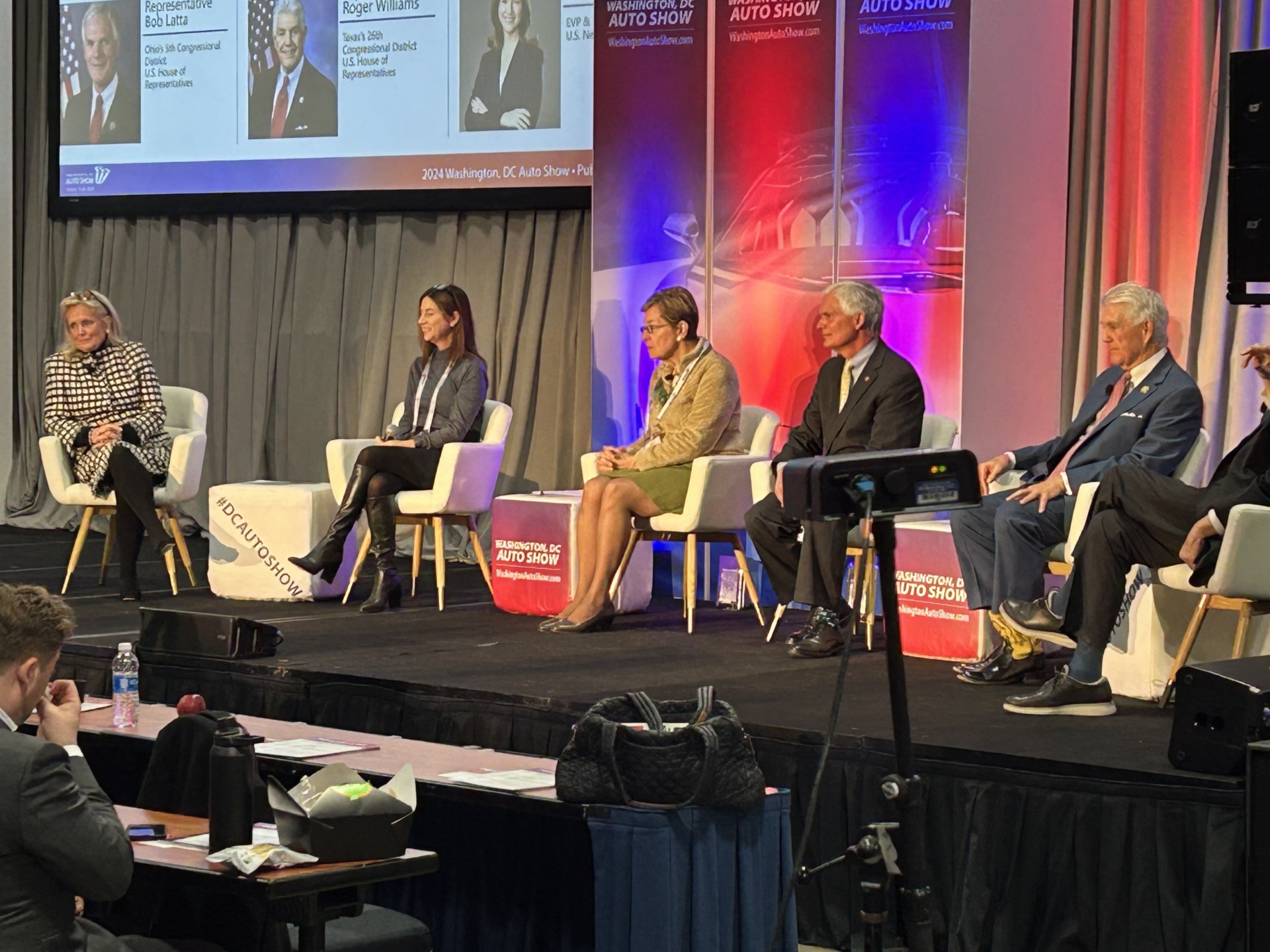
Members of Congress attend a panel discussion at the Washington, DC, auto show on January 18, 2024. From left to right: Rep. Debbie Dingell (D-MI), discussion moderator Dafna Linzer, Rep. Marcy Kaptur (D-OH), Rep. Bob Latta, (R-OH), and Rep. Roger Williams (R-TX). (James Pinkerton/Breitbart News)
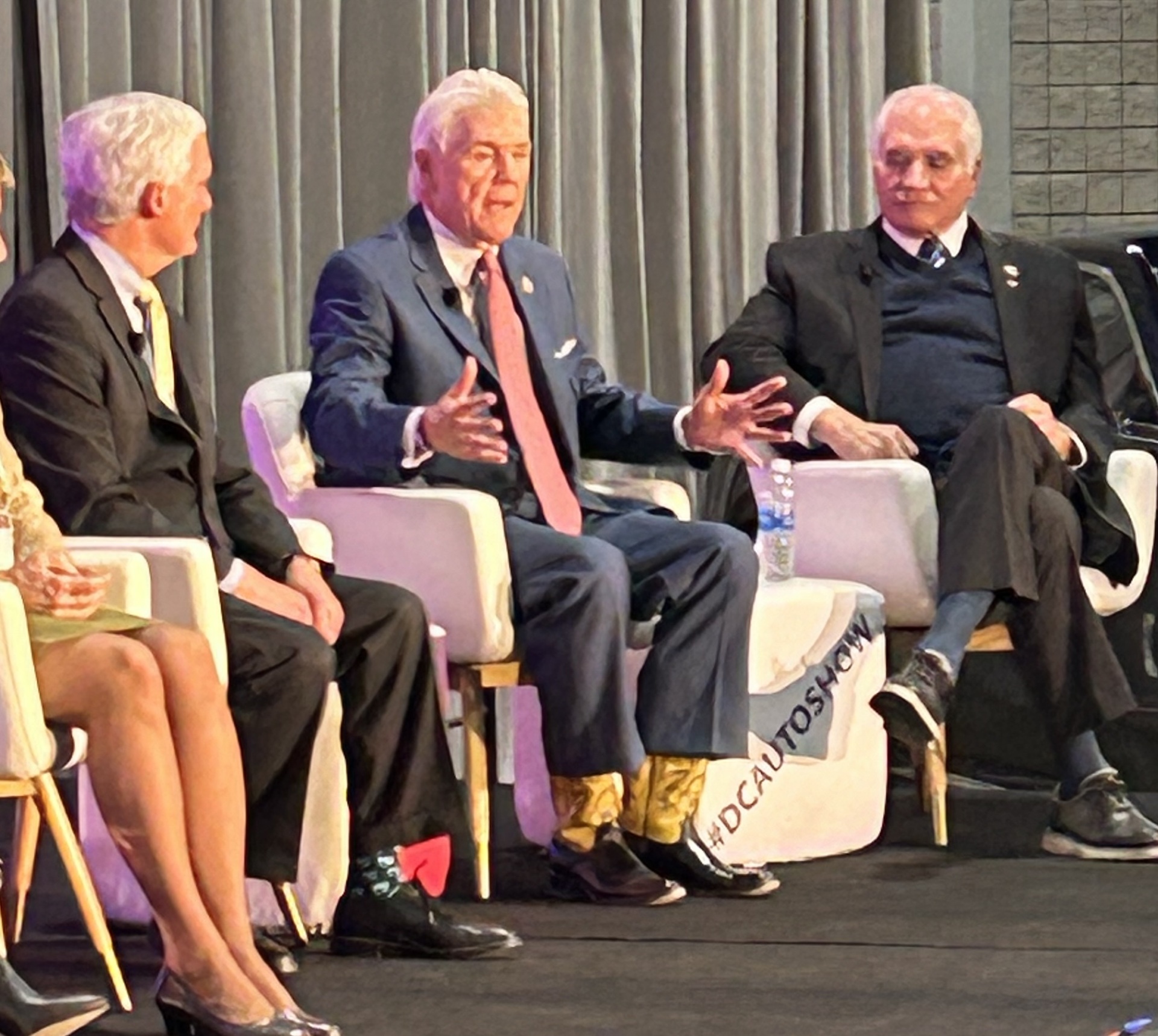
From left to right: Rep. Bob Latta (R-OH), Rep. Roger Williams (R-TX), and Rep. Mike Kelly (R-PA) participate in a panel discussion at the Washington, DC, auto show on January 18, 2024, in Washington, DC. (James Pinkerton/Breitbart News)
Important differences of opinion were illuminated in the give-and-take, which ran well past the program’s allotted time. Democrats tend to admire the green nanny-statism of Europe, but Republicans don’t. Arguably, most Americans agree with the GOP: Here in the US of A, we like gas cars, guns, and smaller government.
Williams further argued that EVs are an opportunity for Chinese leadership since the communist regime has commanded its economy to produce “green” technology—batteries, solar panels—that it can sell to the West. That production, of course, is based on burning coal, which is the cheapest fuel. Yes, it’s weird: China dirties up itself (and the world) so it can sell us “clean” goods. (Coal can be made clean, but you have to clean it.)
In fact, the communist regime manufactures so much non-green greenery that it needs to dump it. According to economic analyst Michael Dunne, writing in Automotive News, “Chinese automakers are awash in excess capacity and a bloody price war at home. They need access to Europe and the U.S. to be profitable.”
For the most part, Biden administration policy says to China, “Bring it.”
The president has signed executive orders and memoranda calling for net zero by 2030 or 2035. (That’s net zero for the U.S., not, of course, for China.) And no, Biden didn’t set these targets in consultation with Congress—Congress wasn’t consulted. The 46th president has taken the same view as the 44th president, Barack Obama, who said, back in 2014, that he could make policy with “a pen and a phone.” That is, bypass Congress and rely on the administrative state.
One problem with this approach: It lacks legitimacy. The president’s policy is greatly strengthened if it has been affirmed by Congress. That’s been the story of both Obama’s 2010 healthcare plan and Donald Trump’s 2017 tax cut. Both were strongly opposed by the other side, and yet since they were written into statute, they have survived the many political assaults since.
A second problem is that unilateral executive actions tend to lack popularity. If the idea were popular, Congress would likely want to pass it. Yet EVs aren’t in that people-pleasing category. Just on January 19, in the latest setback for electrics, Ford announced that it was shrinking its EV production while expanding internal combustion engine (ICE) output.
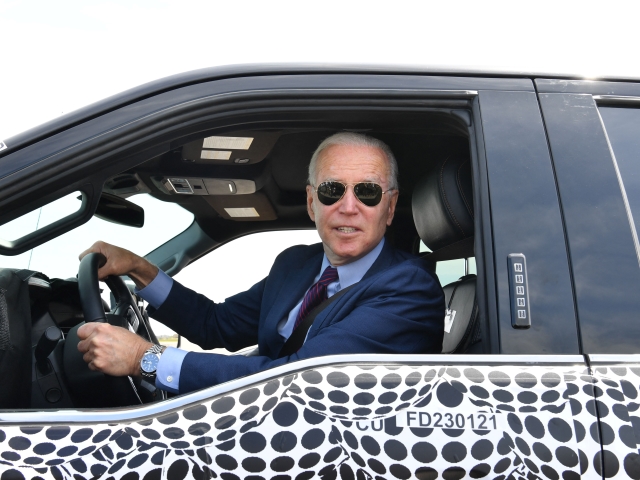
President Joe Biden drives the new electric Ford F-150 Lightning at the Ford Dearborn Development Center in Dearborn, Michigan, on May 18, 2021. (NICHOLAS KAMM/AFP via Getty Images)
What’s ahead? These days, the crystal ball is more likely to be two lenses; one red, one blue. So, both red ICE and blue EVs could be around for a while, albeit clustered in different parts of the country.
Two hues to see the future through. Thankfully, those two Republicans at the auto show want us to have a choice. We’ll see if they get invited back in 2025.
Read the full article here


















